Showing Spotlights 1113 - 1120 of 2876 in category All (newest first):
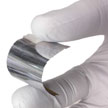 Researchers have demonstrated the fabrication flexible ferroelectric random access memory (FeRAM) devices using state-of-the-art CMOS processes (sputtering, photolithography, and reactive ion etching). This bridges the existing gap between rigid inflexible semiconductor high performance, integration density, yield, and reliable electronics and highly flexible polymer/hybrid materials based relatively low performance electronics. This enables combining the best of two worlds to obtain flexible high performance electronics.
Researchers have demonstrated the fabrication flexible ferroelectric random access memory (FeRAM) devices using state-of-the-art CMOS processes (sputtering, photolithography, and reactive ion etching). This bridges the existing gap between rigid inflexible semiconductor high performance, integration density, yield, and reliable electronics and highly flexible polymer/hybrid materials based relatively low performance electronics. This enables combining the best of two worlds to obtain flexible high performance electronics.
Jul 1st, 2015
 While there is a great deal of knowledge on optical manipulation of metallic nanoparticles in liquids, aerosol trapping of metallic nanoparticles is essentially unexplored. In general, very little is known about optical manipulation of any type of particle in air, where the physics appear to be rather different than in water. The just demonstrated ability to manipulate and study individual metallic or semiconductor nanostructures in air or vacuum opens up many exciting opportunities.
While there is a great deal of knowledge on optical manipulation of metallic nanoparticles in liquids, aerosol trapping of metallic nanoparticles is essentially unexplored. In general, very little is known about optical manipulation of any type of particle in air, where the physics appear to be rather different than in water. The just demonstrated ability to manipulate and study individual metallic or semiconductor nanostructures in air or vacuum opens up many exciting opportunities.
Jun 30th, 2015
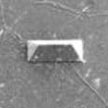 Getting from 2D to 3D has been quite a challenge for the graphene community. The transfer of two-dimensional graphene onto three-dimensional surfaces has proven to be difficult due to the fractures in graphene caused by local stresses. New research is bound to change that. Scientists have demonstrated graphene integration into a variety of different microstructured geometries - pyramids, pillars, domes, inverted pyramids, as well as the integration of hybrid structure of graphene decorated with gold nanoparticles on 3D structures.
Getting from 2D to 3D has been quite a challenge for the graphene community. The transfer of two-dimensional graphene onto three-dimensional surfaces has proven to be difficult due to the fractures in graphene caused by local stresses. New research is bound to change that. Scientists have demonstrated graphene integration into a variety of different microstructured geometries - pyramids, pillars, domes, inverted pyramids, as well as the integration of hybrid structure of graphene decorated with gold nanoparticles on 3D structures.
Jun 29th, 2015
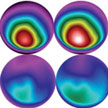 Microwave hyperthermia is one of the most important clinical thermotherapy techniques, however, it is often difficult to apply heat locally to a tumor. By bringing together experts in medicine with experts in nanotechnology, researchers aim to explore the possibilities of designing microwave sensitive agents, which focus the destructive effects of microwaves specifically onto tumor cells. Scientists have now proposed a novel approach to apply micro- and nanomaterials as microwave susceptible agents in tumor hyperthermia in vivo for the first time.
Microwave hyperthermia is one of the most important clinical thermotherapy techniques, however, it is often difficult to apply heat locally to a tumor. By bringing together experts in medicine with experts in nanotechnology, researchers aim to explore the possibilities of designing microwave sensitive agents, which focus the destructive effects of microwaves specifically onto tumor cells. Scientists have now proposed a novel approach to apply micro- and nanomaterials as microwave susceptible agents in tumor hyperthermia in vivo for the first time.
Jun 26th, 2015
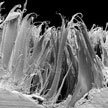 Observations made on a fern and an insect have led researchers to develop a nanofur structure that significantly reduces fluid drag. Both have surfaces covered by high density hairs which allow them to keep an air layer under water. This enables the bug to move nimbly and swiftly through the water by reducing the drag on its surface. Based on these observations, researchers have developed a very inexpensive, highly scalable method to produce a superhydrophobic, air retaining biomimetic surface - a 'nanofur' - which shows not only a high long-term stability but also a high resistance against additional applied pressure.
Observations made on a fern and an insect have led researchers to develop a nanofur structure that significantly reduces fluid drag. Both have surfaces covered by high density hairs which allow them to keep an air layer under water. This enables the bug to move nimbly and swiftly through the water by reducing the drag on its surface. Based on these observations, researchers have developed a very inexpensive, highly scalable method to produce a superhydrophobic, air retaining biomimetic surface - a 'nanofur' - which shows not only a high long-term stability but also a high resistance against additional applied pressure.
Jun 22nd, 2015
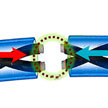 Self-healing of a device is different from material self-healing because the devices contain electronic circuits. Self-healing of a device includes materials self-healing plus alignment of electrodes, which is very difficult but essential. Researchers have now come up with the idea of using magnetic force to assist alignment of electrodes in a circuit, facilitating self-healing of the whole device. To realize this idea, they designed and fabricated an electrically and mechanically self-healable yarn-based supercapacitor by wrapping magnetic electrodes with a self-healing carboxylated polyurethane shell.
Self-healing of a device is different from material self-healing because the devices contain electronic circuits. Self-healing of a device includes materials self-healing plus alignment of electrodes, which is very difficult but essential. Researchers have now come up with the idea of using magnetic force to assist alignment of electrodes in a circuit, facilitating self-healing of the whole device. To realize this idea, they designed and fabricated an electrically and mechanically self-healable yarn-based supercapacitor by wrapping magnetic electrodes with a self-healing carboxylated polyurethane shell.
Jun 19th, 2015
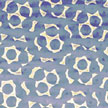 In conventional nanosphere lithography, the nanosphere configurations in the layers are determined by a spontaneous self-assembly process. Therefore, the final configurations are limited to those with or close to the minimal free energy giving rise to very simple patterns. Researchers have now managed to circumvent this thermodynamical restriction by putting the monolayers in a confined environment and constructing the bilayers with sequential stacking, both of which are critical for the formation of moire patterns.
In conventional nanosphere lithography, the nanosphere configurations in the layers are determined by a spontaneous self-assembly process. Therefore, the final configurations are limited to those with or close to the minimal free energy giving rise to very simple patterns. Researchers have now managed to circumvent this thermodynamical restriction by putting the monolayers in a confined environment and constructing the bilayers with sequential stacking, both of which are critical for the formation of moire patterns.
Jun 18th, 2015
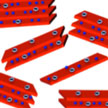 While exploring the possibility to realize graphene-like nanostructures of boron, carbon's neighbor in the periodic table, a team of chemical engineers has discovered an entirely new family of 2-D compounds. They demonstrated exfoliation of a well-known superconductor magnesium diboride, a layered material that consists Mg atoms sandwiched in between born honeycomb planes. These nanosheets can be an order of magnitude more transparent compared to their cousin graphene.
While exploring the possibility to realize graphene-like nanostructures of boron, carbon's neighbor in the periodic table, a team of chemical engineers has discovered an entirely new family of 2-D compounds. They demonstrated exfoliation of a well-known superconductor magnesium diboride, a layered material that consists Mg atoms sandwiched in between born honeycomb planes. These nanosheets can be an order of magnitude more transparent compared to their cousin graphene.
Jun 17th, 2015
 Researchers have demonstrated the fabrication flexible ferroelectric random access memory (FeRAM) devices using state-of-the-art CMOS processes (sputtering, photolithography, and reactive ion etching). This bridges the existing gap between rigid inflexible semiconductor high performance, integration density, yield, and reliable electronics and highly flexible polymer/hybrid materials based relatively low performance electronics. This enables combining the best of two worlds to obtain flexible high performance electronics.
Researchers have demonstrated the fabrication flexible ferroelectric random access memory (FeRAM) devices using state-of-the-art CMOS processes (sputtering, photolithography, and reactive ion etching). This bridges the existing gap between rigid inflexible semiconductor high performance, integration density, yield, and reliable electronics and highly flexible polymer/hybrid materials based relatively low performance electronics. This enables combining the best of two worlds to obtain flexible high performance electronics.
 Subscribe to our Nanotechnology Spotlight feed
Subscribe to our Nanotechnology Spotlight feed





